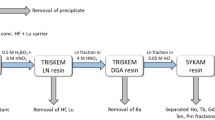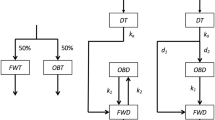Abstract
THE principal radiation exposure of a uranium miner is to the lungs and results from inhaling short-lived 222Rn daughter products (Fig. 1) in the atmosphere1. The short-lived daughters (RaA, RaB, RaC and RaC′) decay in the lung to 22-year 210Pb, of which a fraction is absorbed into the blood stream and stored in the skeleton. Correlation coefficients of 0.84 and 0.77 between exposure to the short-lived daughter products and the 210Pb skeletal burden have been reported2,3, but these studies indicate that the concentration of 210Pb in bone may be as much as four times that expected from the inhalation of the short-lived radon daughter atoms alone3. Less than 10 per cent of additional skeletal 210Pb can be expected from inhaled 222Rn stored in body fat. In order that the concentration of 210Pb in bone should be a valid index of exposure to the 222Rn daughter products, it must be shown that 210Pb atoms supplied by other sources are proportional to the 222Rn daughter concentration.
This is a preview of subscription content, access via your institution
Access options
Subscribe to this journal
Receive 51 print issues and online access
$199.00 per year
only $3.90 per issue
Buy this article
- Purchase on Springer Link
- Instant access to full article PDF
Prices may be subject to local taxes which are calculated during checkout
Similar content being viewed by others
References
Guidance for the Control of Radiation Hazards in Uranium Mining, Federal Radiation Council Report, No. 8, 11 (1967).
Black, S. C., Archer, V. E., Dixon, W. C., and Saccomanno, G., Health Phys., 14, 81 (1968).
Blanchard, R. L., Archer, V. E., and Saccomanno, G., Health Phys. (in the press).
Martz, D. E., Holleman, D. F., McCurdy, D. E., and Schiager, K. E., Health Phys., (in the press).
Black, S. C., Health Phys., 7, 87 (1961).
Blanchard, R. L., Health Phys., 13, 625 (1967).
Lucas, H. F., ANL-6297, 55 (1961).
Control of Radon and Radon Daughters in Uranium Mines and Calculation on Biological Effects, Public Health Service Pub. No. 494 (1956).
Altshuler, B., Nelson, N., and Kuschner, M., Health Phys., 10, 1137 (1964).
Author information
Authors and Affiliations
Rights and permissions
About this article
Cite this article
BLANCHARD, R. Radon-222 Daughter Concentrations in Uranium Mine Atmospheres. Nature 223, 287–289 (1969). https://doi.org/10.1038/223287a0
Received:
Issue Date:
DOI: https://doi.org/10.1038/223287a0
Comments
By submitting a comment you agree to abide by our Terms and Community Guidelines. If you find something abusive or that does not comply with our terms or guidelines please flag it as inappropriate.



